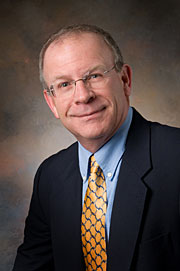- Number 346 |
- September 19, 2011
Waste treatment work leads to new initiatives

Dr. David Hobbs
A project that began a decade ago to enhance radioactive waste operations has led Dr. David Hobbs into a variety of new fields, with exciting results.
In 2001, the senior advisory scientist at DOE’s Savannah River National Laboratory led a team tasked by the Office of Environmental Management with investigating materials that could be used to remove strontium and alpha-emitting radionuclides (principally Pu-238/239, Np-237 and U-235/238) from solutions for disposal. The national team set out to decipher the characteristics of a commonly used sorbent that enable it to sorb selected elements. They then put that knowledge to work to structurally modify the sorbent to improve its ability to remove the targeted radionuclides.
“The initial thrust — developing a material for the pretreatment of radioactive waste — produced extremely useful results,” Dr. Hobbs said. “DOE had selected the sorbent called MST (monosodium titanate) as the best method for decontaminating the Savannah River Site’s salt waste solutions, removing strontium and actinides so those highly radioactive elements could be disposed with the high-level waste. Our task was to understand how to modify the MST to improve its performance. The modified sorbent that resulted can increase throughput three-fold, using one-fourth the amount of the currently used sorbent.”
Then things really got interesting for the chemist best known for his work with high-level nuclear wastes. “The same knowledge that allowed us to increase the sorbent’s capabilities in treating high-level nuclear wastes suggested that these materials might be useful in other applications such as in industrial wastewater treatment and perhaps in medicine to remove toxic metals,” he said. The work took an unexpected twist when we discovered that the titanates could serve as a platform to deliver therapeutic metals in biological environments. In vitro testing by our collaborators at Georgia Health Sciences University and the University of Washington has shown that the metal titanates inhibit cancer and bacterial cell growth.
Building on that work, Dr. Hobbs and his partners, including colleagues at Sandia National Laboratories, have now developed synthetic techniques to produce nanosize metal titanates. Initial results indicate that the nanosize titanates offer enhanced performance and was instrumental in being awarded a grant from the National Institutes of Health to investigate these materials as additives to extend the lifetime of dental composites.
Current testing is exploring other novel applications such as photocatalysts for the removal of organic contaminants and as catalysts in fuel cells and solar cells. “It has been an exciting decade of research and rewarding to contribute to the cleanup of radioactive waste as well as take materials developed for one application and see opportunities to use them beneficially in other areas,” he said.Submitted by DOE's Savannah River National Laboratory
